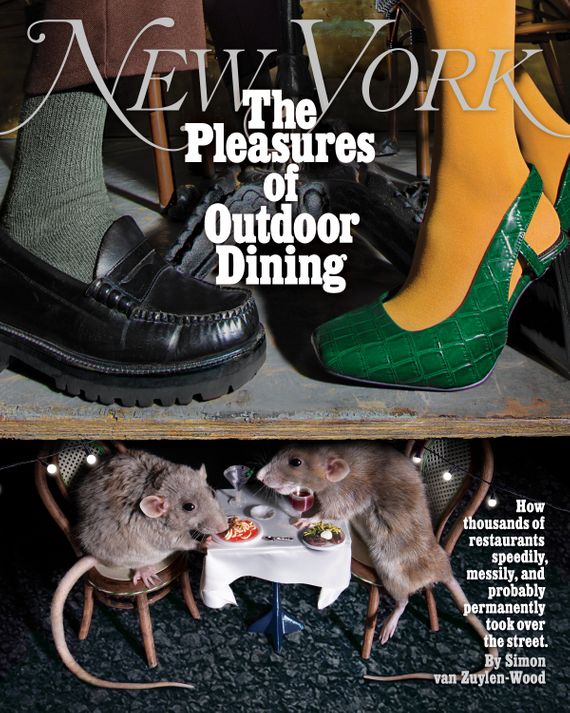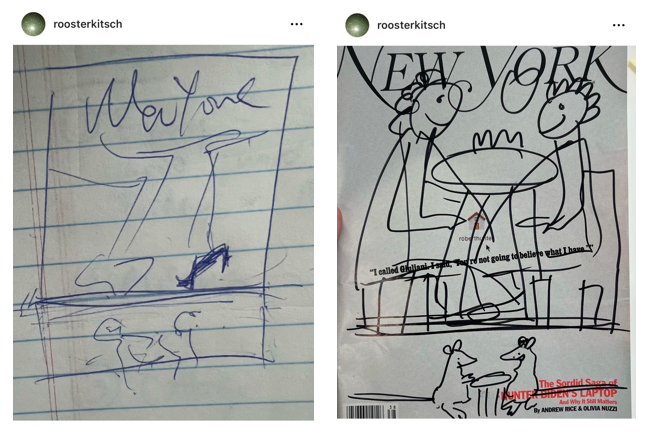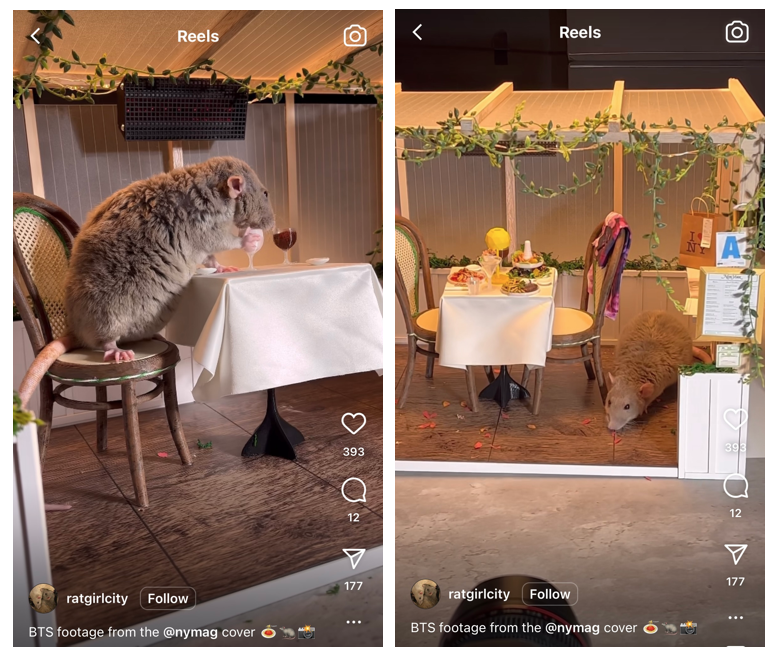Taro and Mishi Take Manhattan
The charming tale of how two humble rats made it from Bed-Stuy to become New York magazine cover stars

Of the two rats featured on the cover of the October 24 issue of New York magazine, Taro is the more natural star. “She’s always been very courageous and loves to explore wherever she is. Sometimes if the cage is open, she’ll just start climbing the outside of the cage and end up wherever she can go,” their owner, Liana Tan Perez, told The Fine Print. “She definitely was really popular on set. Everyone wanted to give her a little cuddle because she loved to get the attention and loved sniffing around and meeting new people.” Mishi has always been more reserved, but she has a slow-growing charm. “For the first maybe six months I had Mishi, she would bite me if I put my hand close to her in the cage, but we kind of just worked through that,” Perez said. “Now she’ll just sit on my lap and she grooms my hand — that’s how they socialize, rats will groom each other.” Together Taro and Mishi, eating tiny spaghetti and steak frites beneath a thin layer of plywood under human diners, represented an oft-forgotten group of stakeholders in the conversation about the streeteries that popped up around New York during the pandemic — the subject of the issue’s cover story. “It’s one of those covers that you’ll look at in the sea of all the others, and it truly captures an era,” said New York photo director Jody Quon, “a moment that we all will remember so vividly forever.”
When not modeling for magazine covers, Taro and Mishi spend most of their days in their cage in Perez’s apartment in Bed-Stuy. “They cuddle all day and sleep and then just wait for me to come home so that I can give them treats,” Perez said. Until earlier this year, they lived in the East Village, where Perez was raised. “Growing up in New York City, you would think that I would hate them, but I always loved rat-watching on the subway,” she said. “I always wanted a pet rat, but my mom was kind of scared of them, so I always had hamsters. Then, when I was older and I had my own money and I was in college, I was like, ‘You know what?’ — I’d been following this rat Instagram for a long time, this rat breeder in Long Island — and one day, I was just like, ‘You know what? I’m gonna go get some rats.’” This was in 2020, near the height of the pandemic. “These were my pandemic pets, my little rats,” she said. Their cage is three by four by two feet. “They live in a rat mansion,” Perez said. “They have a bunch of different baskets and little pods that they sleep in all throughout it, because you need to make the cage very interactive, always be kind of switching it up to intellectually stimulate them. They really are so smart that they need to experience something new all the time.”
The idea of having rats on the cover started with New York editor-in-chief David Haskell. (This isn’t the first time Haskell’s zeroed in on rats.) “David said, ‘If we do the streetery story on the cover, I think we could do something with rats eating or rats in a streetery.’ He sort of teed that up,” said deputy photo director Liana Blum, who was in charge of making the cover happen. “My mind went to taxidermy. ‘Is it taxidermy rats? Is it humans dressed in rat costumes?’ A couple of days later, it was like, ‘Oh, real rats could work.’ Then we brainstormed over a weekend, came in on Monday, and all sketched out what we had in our heads.” Haskell’s sketch showed the rats dining under human diners.

“When I saw that, I was like, ‘Whoa, okay, that’s going to be tricky. How do we do that?’” Blum said. “The next 24 hours were spent figuring out how to execute on this idea that David had very clearly in his mind. There were iterations of how to put together the right team: the right rats, the right set designer, the right photographer. Do we build a life-sized streetery in a studio? Do we shoot it in the world? Do we shoot the rats in the studio or in the world?”
The watchword for every aspect of the cover was speed. “I was on the road outside of Chicago, working on a different story in late September, when I got the call saying, ‘How do you feel about this story?’ And I thought, ‘I feel amazing about it. Let’s do it.’ So it was four weeks total from conception to publication,” Simon van Zuylen-Wood, who wrote the story, told The Fine Print at a bar last Wednesday. “There was no choice: It was just like, ‘Okay, this is gonna be on the cover. Go make it happen.’ There’s something super inspiring and exhilarating about having no choice. A total adrenaline trip.”
It wasn’t just part of the personal experience of people working on the cover: Speed can impart its own aesthetic qualities. “If you have too much time to brew and stew,” Quon said, “you don’t get the visceral energy that you need to make something really magical.” They selected Beth Sacca to take the photos. “She can photograph something as eerie as rats but still have it feel like Stuart Little because she has a pop, very positive, upbeat aesthetic,” Quon said. “We didn’t want the cover to go dark, so that was the balance.” Sacca suggested miniaturist Phillip Nuveen to build a tiny streetery, and Blum was left to find some rats.
“I’ve cast many animals in my career, and I’ve always found that working with people’s pets is the easiest way to go,” Blum said. “We did reach out to a professional animal handler for this. There is a company that the industry uses a lot. They were like, ‘It would take months to train rats to sit in chairs, and they’ll bite you.’ They were very skeptical and said that they couldn’t help us. So I just put a post out on my personal Instagram account asking if any of my followers had pet rats. I got a couple responses instantly.” When she first saw Blum’s Instagram post searching for photogenic rodents, Perez wasn’t totally sure Taro and Mishi would be natural models, but she overcame that nervousness. “Some photos started flowing in,” Blum said, “and Taro and Mishi were clearly the winners.”
On the morning of Monday, October 17, the day of their shoot, Perez took Taro and Mishi with her to work in Brooklyn. “They were just in the carrier all morning, just kind of sleeping,” she said. Meanwhile, at New York’s offices at 250 Vesey Street, photographer Sacca and miniaturist Nuveen were preparing the studio. “The photographer and the set designer arrived first and set up a couple of different lighting scenarios and tweaked everything so that we were ready for when the rats arrived, because you don’t want to keep talent waiting,” Blum said.
Nuveen was in the final stages of a condensed process. He’d gotten the call the preceding Wednesday night, spoke with the team at New York on Thursday, and got to work in Bushwick the next day. Perez sent him pictures of Taro and Mishi against a ruler. “I was nervous that they were going to be really big, because you know how rats get really big,” he said, “but they were, I think, 10 inches if they were stretched upstanding and six or seven inches if they were sitting or hunched over, so they were perfect for one-sixth scale, which is Barbie play scale, a very standard scale that’s out there for miniatures.”

Nuveen 3D-printed the tiny furniture and glassware, taking particular care with the chairs. “I didn’t know how much they were gonna thrash around, and I wasn’t sure how heavy they would be, so I printed them completely with 100 percent infill, so they’d be unbreakably sturdy. That took about three hours per section,” he said. “I didn’t want a leg to snap if they knocked the chair over.” He built the rest of the set by hand. “You could 3D-print something that big, but it would take weeks,” he said. For the heating lamp in the more detailed version of the streetery featured behind the issue’s table of contents, he broke out several methods. “The heating lamp was a strand of LED fairy lights, but I made a little aluminum enclosure, and then I had some grill-like material that I painted black,” he said. “Then I had some red film gel that I put over it to make it glow red.” He only had a long weekend to build the whole thing: “I worked on it Friday, Saturday, Sunday, and then I brought it into the city Monday, and we shot.”
The rats arrived around noon. Sacca shot the diners’ shoes, which belong to human models Massimo Marchese and Aliesha Hatalovsky, on a different day, so it was just Taro and Mishi and the tiny streetery on a table in the studio. “We let them acclimate to the set. We took everything away so that they could sniff around and make themselves comfortable,” said Blum. “We experimented with what foods they liked best and how to get them to concentrate and stay put because they’re quite skittish.” Usually, Taro and Mishi, like Perez, are vegan. Their favorite green is arugula. “That’s what they always went crazy over and were super excited about,” said Perez. “Even over some fruit, they’d rather have arugula.”
But they needed a higher caliber treat to focus their attention on the work at hand. “We tried to use these baby puffs that they give for babies, that’s what I give the rats as treats, but they weren’t as interested,” said Perez. “So I was like, ‘Hey, what do we have here? Do we have yogurt?’ And they’re like, ‘Oh, yeah, we have carrots, we have yogurt.’ And I was like, ‘I think yogurt might be good, because they’ll sit and lick it, rather than just run away with it.’ And luckily, they had some in their kitchen.” The yogurt allowed them to shoot the rats handling the glassware. “We filled those little plastic wine glasses with yogurt,” said Blum. “Literally, on the TOC page, you see his little paw wrapped around the glass and that was not faked. He was holding it and eating yogurt out of the little glass.”

There were only about five people on the set most of the time, but there were a variety of reactions to Taro and Mishi. “I think a lot of people were kind of apprehensive to be interacting with a rat,” said Perez, “but then others were gung ho, super excited.” Sacca seemed to be among the apprehensive. “Some of the people on set were interested in getting some cuddles,” Blum said, “Beth, I think, was happy to keep her distance.” Did the shoot change any of their relationships with the rats they see around the city? “Not mine,” said Quon. “I’ve always thought they were sort of cute,” added Blum. “If it weren’t for those tails, they’d be really cute,” said Nuveen. “But no, I will still always scream when I see rats run in front of me on the street.”
Taro and Mishi were tuckered out by the end of the day. “I was doing work while they were going through photos,” said Perez, “and I had both of them on my belly a little bit, just chilling out. I think they were really, really tired. They passed out in my little sweater and just stayed with me while I was doing work.” They headed home in an Uber around six, asleep most of the way. At the apartment, Perez streamed behind-the-scenes footage and pictures from the day for her roommates on their TV, but the rats were ready to return to their cage. “They just all went into a little cuddle pile and fell asleep again,” she said.
A week later, the issue was published. “I showed one of my roommates the cover when I got it, and she almost started crying,” said Perez, “she was so excited,” The photo department had expected the cover to hit. “Once we knew it was working, we could naturally anticipate the reception that it’s gotten,” said Quon. “It touches everything and touches everyone’s experience of these last three years. It’s so brilliantly done.” Followers started flowing into the rats’ Instagram account. “I didn’t think that it would be that popular. I didn’t even think they would tag the Instagram that I have for them,” said Perez. “I was so excited. There’s nothing more I love than my rats. I’m like full rat mom, I love them so much.” Then over Halloween weekend, someone she didn’t know dressed up as one of them. “She replied being like, ‘I was Taro specifically,’” Perez recalled, “which really blew my mind.”
Taro and Mishi seem unaffected by their newfound notoriety. “They don’t know what’s going on. They didn’t know they got paid for it. They don’t know anything,” said Perez. Will they be available for future rat shoots? “I’d definitely be open to it. It wasn’t really stressful for them, which is good, but I don’t think I would make it a full-time job being a rat agent,” she said. “I mean, I have a lot of vet bills that I need to pay, so it was good that I got them working to pay it all back.”
